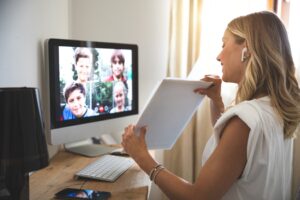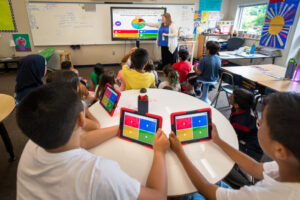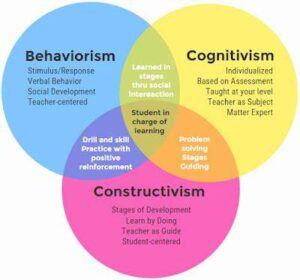Introduction
As an educator from India, my journey in teaching has been nothing short of an adventure, with twists and turns that have challenged and reshaped my beliefs about knowledge and learning. Beginning my professional journey in a conventional educational setting, where technology was perceived as a far-right rather than a useful instrument, I could not have foreseen the profound transformation that the COVID-19 epidemic would precipitate, immersing me in an entirely new domain of online education. Today, I reflect on how these experiences have influenced my teaching philosophy and practices.

Embracing Tradition in India
During the initial stages of my teaching profession, I strongly adhered to the fundamental principles of conventional teaching methodologies. The blackboard, chalk, and direct interpersonal exchanges were my reliable companions. The classroom served as a sacred environment where knowledge was conveyed through individualized instruction, fostering a collective learning experience. The world was characterized by simplicity, with a strong emphasis on the concept that effective teaching relied heavily on human interaction.

The Digital Revolution
Subsequently, the epidemic emerged, causing significant disruption to the stillness of our conventional classrooms. Compelled to navigate the unfamiliar realm of online education, I found myself exploring platforms such as Zoom, Google Classroom, and applications like Kahoot. The move was highly challenging as it confronted my deeply ingrained ideas and forced me to step outside my comfort zone. How can interpersonal connection be maintained in a digital environment? Could the fundamental nature of education be compromised amidst the emergence of digital platforms and technologies?
A Shift in Perspective
Surprisingly, the transition to online teaching yielded unexpected discoveries. Theories of learning that were previously limited to the physical classroom expanded in scope when applied to the digital domain. Virtual talks allowed an entirely new form of inclusion by overcoming geographical limitations and creating a global learning community. Technology evolved from being only a means of survival to becoming a pathway to new opportunities. 
Applications such as Kahoot introduced gamification to evaluations, transforming ordinary quizzes into captivating competitions. The formerly feared exams transformed into occasions for students to demonstrate their expertise in an enjoyable and engaging manner. Observing the favorable influence of technology on student involvement, my doubt gradually diminished, and I began to recognize the possibility of a balanced integration of conventional methods and modern advancements. I have also mentioned the evolution of technology through behaviorism, cognitivism, and constructivism in my previous blog (please take a look), which has enhanced my knowledge and function of work.
A Leap into the Technological Future 
The continuation of my adventure did not cease at that point. Engaging in advanced studies in a setting where technology was not merely a choice but a paramount concern, I discovered myself fully immersed in a multitude of opportunities. Classes based on cutting-edge technologies, virtual realities, and collaborative software have become the norm. My understanding of knowledge transcended the limitations of traditional textbooks as I immersed myself in the dynamic realm of e-learning.
The once intimidating software and applications have become indispensable tools for promoting engaging and dynamic learning experiences. Zoom evolved from being an essential tool during the pandemic to becoming a platform for interactive virtual courses and debates. Google Classroom served as a digital sanctuary for effortlessly managing resources and homework. Evaluation applications offer immediate feedback, enabling prompt interventions and customized learning pathways.
Conclusion
My exploration of theories of knowledge and learning has been a dynamic experience, encompassing both traditional Indian perspectives and the technologically advanced environments of higher education. The pandemic compelled me to adjust, questioning my views and ultimately enhancing my teaching philosophy. As I navigate the ever-changing combination of tradition and technology, I bring with me the knowledge gained from each phase of my teaching career, which demonstrates the enduring strength of education in adapting to change. Lastly, I would like to say thanks to Katia and the courses I am presently undertaking, as well as others I have previously completed with her. These courses have greatly facilitated my exploration of technology in education.
Indeed these courses on Edtech have been a great addition to my knowledge. All that I did earlier did not have the base of education but it was a base of exploration. Through these classes the exploration is more collaborative and guided too.
The journey mentioned by you is something with which I myself relate. As facilitators the best thing that we learned from the pandemic is the ease of seamlessness in imparting education. It was a good read. Thanks
Hi Jashandeep,
Although we are from different countries, we have shared teaching experience in our respective nations. Relying heavily on the teacher as the main source of information, the chalkboard that offered a unique and tactile experience and one size fits all instructions were characteristics that enhanced the traditional classroom setting back home. Coming to Canada and affected by epidemics we were forced to move from our comfort zone and adapt to the new reality. Faced with apps and programs that we never used in the classroom before, was a real challenge, at least for me. But we chose to accept that challenge and embrace the new opportunities to grow professionally and to offer the best education to our students. This transition demanded an incorporation of technology with individualized instruction to accommodate diverse learning styles. Embracing change has not only enriched our teaching experiences and practices but at the same time broadened our perspective in education.
Hi, Jashandeep.
Thank you for your perspectives. It is always interesting to here the thoughts surrounding education from other cultures and countries. I had the opportunity to work alongside a teacher last year from India and we certainly had different experiences growing up. Those experiences can really shape us in what we believe moving forward into our teaching career.
What you said about the different softwares being intimidated hits home for me as well. There are so many different options and tools out there, but with a little bit of practice and slow integration, they can be amazing assets like you said! Although sometimes we aren’t afforded slow integration (ex. when a pandemic literally shuts down the whole world and forces us to use something).
Jashandeep, reading about your experience teaching in India and how your perspectives changed based on external circumstances, such as the pandemic, is really interesting. Your description of the classroom in India as a “sacred space” conveys well the stark difference between in-person and online learning. It’s inspiring how you immersed yourself in the digital world and adjusted your perspective on education. Thanks for sharing!
This was a great read, Jashan! I particularly resonated with this thought of yours:
“How can interpersonal connection be maintained in a digital environment?”
I found it was so difficult to maintain that interpersonal connection through online learning in the COVID-19 pandemic. I think this is such an important part of education as well.
I enjoy reading about your experience teaching in India vs. Canada as well.